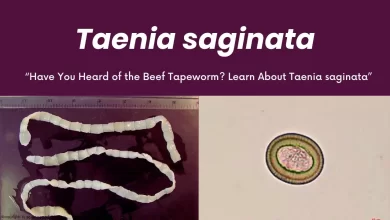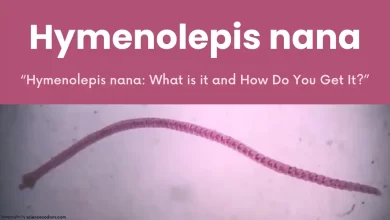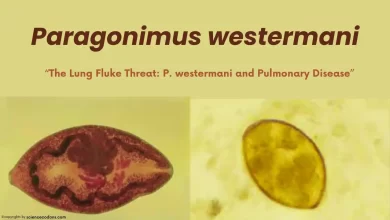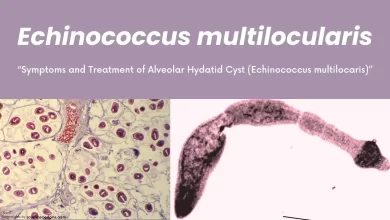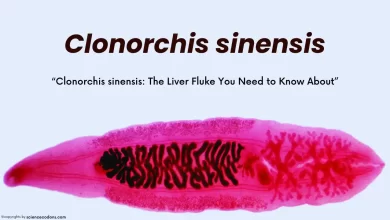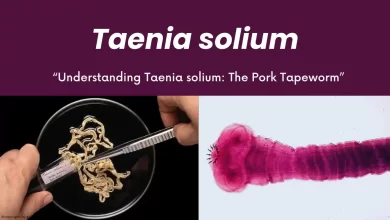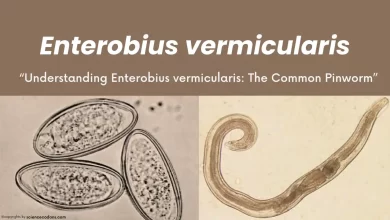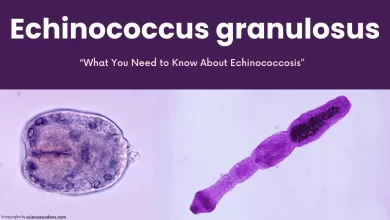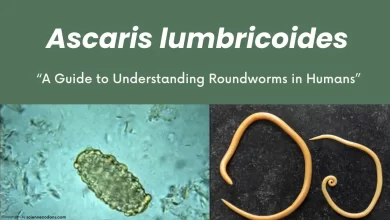Diphyllobothrium latum, commonly known as the broad fish tapeworm, is a parasitic cestode that can cause diphyllobothriasis in humans.
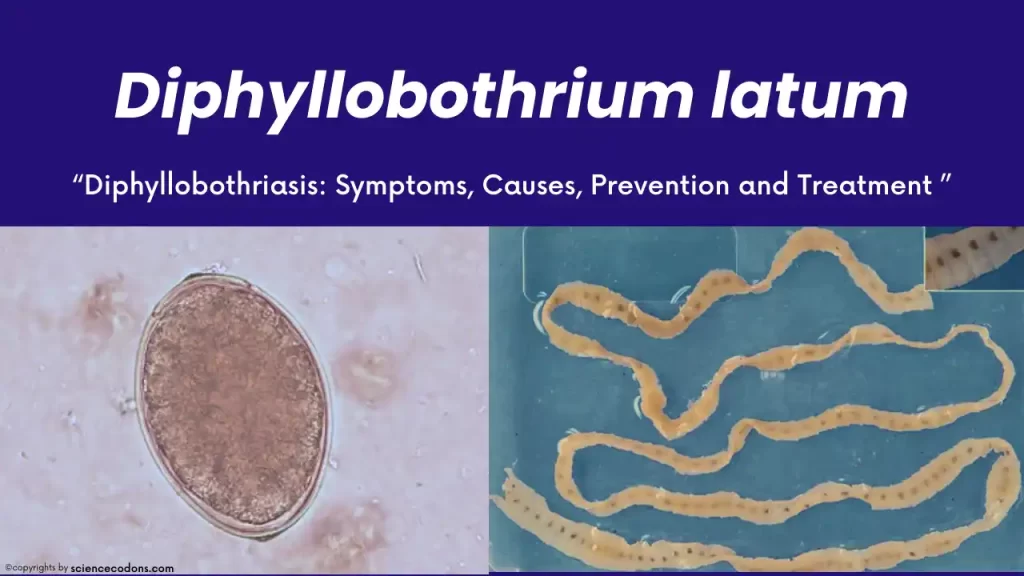
D. latum is a significant member of the Pseudophyllidea order and the Diphyllobothriidae family of cestodes. This parasite can grow exceptionally long and cause digestive discomfort and symptoms and megaloblastic anemia. The name ‘Diphyllobothrium latum’ is derived from three parts that highlight the main characteristics of this parasite:
- ‘Di‘: signifies ‘two’
- ‘Bothrium‘: refers to ‘Bothria,’ the longitudinal grooves of the sucker
- ‘Latum‘: means’ wide and flat’
What is D. latum? [Morphology & Characteristics]
Diphyllobothrium latum is the longest cestode infecting humans, reaching lengths of up to 25 meters. Approximately 20 million people worldwide are infected with this cestode. Fish-eaters can primarily act as reservoirs for this disease. The parasite is white or milky in color and has between 3000 and 4000 segments. It can live up to 25 years in humans.
Diphyllobothrium latum has a duck-like scolex and has two bothria or longitudinal suction grooves that are shallow and used for attachment. The fertile segments are broad. (Width greater than length). The GP (genital pore) is not lateral and is in the middle of the segment. The uterus is rose-form (red rose). The eggs are oval, have an operculum, and usually their size is 40-70 microns and are seen in yellow. They have an indistinct operculum. Opposite the operculum, a protrusion or appendage called a “knob” is seen. The adult Diphyllobothrium latum worm can excrete up to one million eggs daily. The eggs are from the category of unripe eggs and must stay in the environment for a while to mature. The tests are spread throughout the segment.
The life cycle of Diphyllobothrium latum
The life cycle of D. latum begins in the digestive system of humans and other primary hosts such as dogs and cats. The eggs are excreted through the uterine pore. These eggs are unripe and mature within 10 to 15 days in water. Inside them, a first larval stage called coracidium is formed.
The coracidium is a six-hooked embryo (oncosphere) with cilia on its surface and is used to swim in water. Its lifespan is 12 to 48 hours, and during this time, it reaches the first intermediate host, a group of aquatic crustaceans or cyclops. When it enters the cyclops, the second larval stage or procercoid is formed. If this cyclops is hunted and eaten by a fish, within 1 to 4 weeks in the fish’s muscles, the third larval stage or plerocercoid or sparganum is formed.
Humans and final hosts: if they consume this fish infected with Diphyllobothrium latum (raw or half-cooked), the fish muscles are digested in the human body. Within 3 to 6 weeks, the worm in the intestine of the final host matures and begins to excrete eggs.
| Stage | Description |
|---|---|
| Egg | Passed un-embryonated in feces. |
| Oncosphere Formation | Eggs mature (approximately 18 to 20 days) and yield oncospheres. |
| Coracidia | Ingested by a suitable crustacean (first intermediate host). |
| Procercoid Larvae | Develop within the crustacean. |
| Second Intermediate Host | Usually a small fish that preys on the crustacean. |
| Plerocercoid Larvae (Spargana) | Infectious stage: develops in deeper tissues of the second intermediate host. |
| Paratenic Hosts | Larger predator species that consume small fish with plerocercoids. |
| Human Infection | Humans acquire the parasite by consuming undercooked paratenic host fish. |
| Adult Tapeworms | Develop in the small intestine, reaching lengths of over 10 meters with more than 3,000 proglottids. |
Diagnosis and Symptoms of Diphyllobothriasis
typically, The diagnosis of Diphyllobothrium latum is based on the symptoms it produces. Some references liken its symptoms to those of stomach ulcers. However, the key to diagnosis is the anemia associated with Vitamin B12 deficiency, which is a type of Macrocytic anemia. The red blood cell (RBC) size is usually larger than normal in this condition. The patient’s history of consuming raw fish aids in the diagnosis. A stool test, where segments or unripe eggs are observed, also assists in the diagnosis.
Depending on the entry location and the part of the intestine it affects, D. latum usually causes digestive symptoms, such as digestive discomfort, diarrhea, and constipation. Generally, its common symptoms include weight loss and anemia associated with Vitamin B12 deficiency, which is seen in 40% of patients. This is due to the worm absorbing Vitamin B12, which is essential for the production of red blood cells. If a sufficient amount is not received, megaloblastic anemia occurs.
| Symptom | Description |
|---|---|
| Abdominal Discomfort | Mild discomfort or pain in the abdominal area. |
| Diarrhea | Frequent, loose, or watery stools. |
| Vomiting | Nausea followed by the act of vomiting. |
| Weight Loss | Unintended loss of body weight. |
| Vitamin B12 Deficiency | Fish tapeworms can absorb dietary vitamin B12, leading to deficiency and occasionally resulting in megaloblastic anemia. |
| Rare Complications | Heavy infection may cause intestinal obstruction due to migration of proglottids (tapeworm segments) or gallbladder disease. |
Prevention and Treatment of Diphyllobothrium latum
Prevention
To prevent infection from D. latum, one should avoid eating infected fish found in contaminated waters, especially fish from areas where sewage is discharged into the water. Also, to eliminate this parasite, fish should be consumed cooked (10 minutes of cooking the fish causes the worm to die). Freezing fish at a temperature of minus 20 degrees for 24-48 hours eliminates the larvae present in the fish meat.
Treatment
In the treatment of this parasite, two drugs, praziquantel and niclosamide, are used. These drugs paralyze the worm, causing it to be expelled.
- Praziquantel is administered as a single dose at 40 milligrams per kilogram of body weight.
- Niclosamide is administered as a single dose of 2 grams.
Please note that drug use must be under the supervision of a doctor, and self-medication should be avoided.
Conclusion
Diphyllobothrium latum is a significant parasitic health concern, especially in regions where raw or undercooked fish consumption is common. Understanding this tapeworm’s lifecycle, transmission, and prevention is essential for reducing the risk of infection and safeguarding public health.
Reference
- Chapter 55: Diphyllobothriasis from Mandell, Douglas,
- Bennett’s Principles and Practice of Infectious Diseases (9th Edition) by Gerald L
- Diphyllobothrium latum infection (diphyllobothriasis) by C.P. Thakur in Clinical Microbiology Reviews (Volume 18, Issue 1, January 2005)
- Georgis’ Parasitology for Veterinarians – E-Book, 10th Edition
- https://doi.org/10.1371/journal.pntd.0002535
- Scholz, Tomáš, et al. “Update on the human broad tapeworm (genus Diphyllobothrium), including clinical relevance.” Clinical microbiology reviews 22.1 (2009): 146-160.
